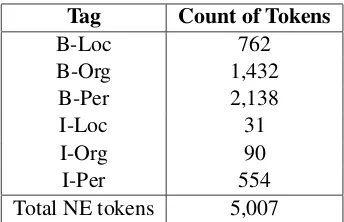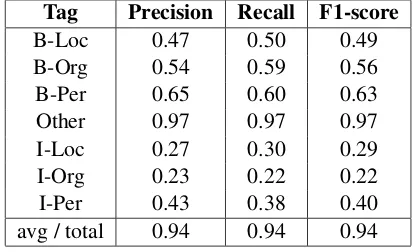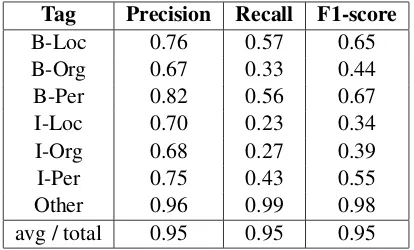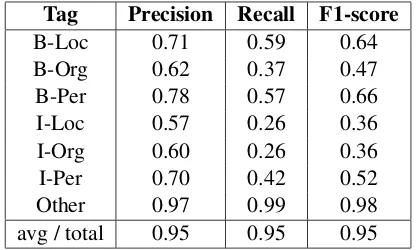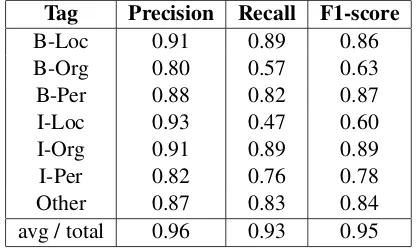Proceedings of the Seventh Named Entities Workshop, pages 27–35 27
Named Entity Recognition for Hindi-English Code-Mixed Social Media
Text
Vinay Singh, Deepanshu Vijay, Syed S. Akhtar, Manish Shrivastava
Language Technologies Research Centre (LTRC)
International Institute of Information Technology Hyderabad, Telangana, India
{vinay.singh, deepanshu.vijay, syed.akhtar}@research.iiit.ac.in m.shrivastava@iiit.ac.in
Abstract
Named Entity Recognition (NER) is a major task in the field of Natural Lan-guage Processing (NLP), and also is a sub-task of Information Extraction. The chal-lenge of NER for tweets lies in the in-sufficient information available in a tweet. There has been a significant amount of work done related to entity extraction, but only for resource-rich languages and do-mains such as the newswire. Entity ex-traction is, in general, a challenging task for such an informal text, and code-mixed text further complicates the process with it’s unstructured and incomplete informa-tion. We propose experiments with dif-ferent machine learning classification al-gorithms with word, character and lexical features. The algorithms we experimented with are Decision tree, Long Short-Term Memory (LSTM), and Conditional Ran-dom Field (CRF). In this paper, we present a corpus for NER in Hindi-English Code-Mixed along with extensive experiments on our machine learning models which achieved the best f1-score of 0.95 with both CRF and LSTM.
1 Introduction
Multilingual speakers often switch back and forth between languages when speaking or writing, mostly in informal settings. This language inter-change involves complex grammar, and the terms “code-switching” and “code-mixing” are used to describe it Lipski. Code-mixing refers to the use of linguistic units from different languages in a single utterance or sentence, whereas code-switching refers to the co-occurrence of speech ex-tracts belonging to two different grammatical
sys-temsGumperz. As both phenomena are frequently observed on social media platforms in similar con-texts, we use only the code-mixing scenario in this work.
Following are some instances from a Twitter corpus of Hindi-English code-mixed texts also transliterated in English.
T1 : “Finally India away series jeetne mein successful ho hi gayi :D”
Translation: “Finally India got success in winning the away series :D”
T2 : “This is a big surprise that Rahul Gandhi congress ke naye president hain.”
Translation: “This is a big surprise that Rahul Gandhi is the new president of Congress.”
introduced a bit late. Chieu and NgA shared task in FIRE-15 workshop1and explicitly NER task on Code-Mixed in FIRE 20162.
The structure of the paper is as follows. In Section 2, we review related research in the area of Named Entity Extraction on code-mixed social media texts. In Section 3, we describe the corpus creation and annotation scheme. In Section 4, we discuss the data statistics. In Section 5, we sum-marize our classification systems which includes the pre-processing steps and construction of fea-ture vector. In Section 6, we present the results of experiments conducted using various character, word level and lexical features using different ma-chine learning models. In the last section, we con-clude our paper, followed by future work and the references.
2 Background and Related work
Bali et al. performed analysis of data from Face-book posts generated by English-Hindi bilingual users. Analysis depicted that significant amount of code-mixing was present in the posts. Vyas et al. formalized the problem, created a POS tag annotated Hindi-English code-mixed corpus and reported the challenges and problems in the Hindi-English code-mixed text. They also performed experiments on language identification, translit-eration, normalization and POS tagging of the Dataset. Sharma et al. addressed the problem of shallow parsing of Hindi-English code-mixed so-cial media text and developed a system for Hindi-English code-mixed text that can identify the lan-guage of the words, normalize them to their stan-dard forms, assign them their POS tag and seg-ment into chunks. Barman et al. addressed the problem of language identification on Bengali-Hindi-English Facebook comments.
In Named Entity Recognition there has been significant research done so far in English and other resource rich languagesMorwal et al.; Sri-hari et al., but same cannot be said for code-mixed text due to lack of structured resources in this do-main.Bhargava et al.proposed a hybrid model for NER on Hindi-English and Tamil-English code-mixed Dataset. Bhat et al. proposed a neural network architecture for NER on Hindi-English code-mixed Dataset. Code-mixing got attention in FIRE-2016 with the introduction of tasks on
Code-1
http://fire.irsi.res.in/fire/2015/home
2http://www.au-kbc.org/nlp/CMEE-FIRE2016/
Mixed resources. Now code-mixing has found its application in different areas such as Query Label-ingBhargava et al., Sentiment AnalysisBhargava et al., Question Classification etc.
3 Corpus and Annotation
The corpus that we created for Hindi-English code-mixed tweets contains tweets from last 8 years on topics like politics, social events, sports, etc. from the Indian subcontinent perspective. The tweets were scrapped from Twitter using the Twit-ter Python API3 which uses the advanced search option of twitter. The mining of the tweets are done using some specific hash-tags and are mined in a json format which consist all the informa-tion regarding the tweets like time-stamps, URL, text, user, replies, etc. Extensive pre-processing (Section 5.4) was carried out to remove the noisy and non-useful tweets. Noisy tweets are the ones which comprise only of hashtags or urls. Also, tweets in which languages other than Hindi or En-glish are used were also considered as noisy and hence removed from the corpus . Furthermore, all the tweets which were either in only English or used Devanagari script text are removed too, keep-ing only the code-mixed tweets. Further cleankeep-ing of data is done in the annotation phase.
3.1 Annotation: Named Entity Tagging
We label the tags with the present three Named Entity tags ‘Person’, ‘Organization’, ‘Location’, which using the BIO standard become six NE tags (B-Tag referring to beginning of a named entity and I-Tag refers to the intermediate of the entity) along with the ‘Other’ tag to all those which don’t lie in any of the six NE tags.
‘Per’ tag refers to the ‘Person’ entity which is the name of a Person, twitter handles and common nick names of people. The ‘B-Per’ states the beginning and ‘I-Per’ for the name of the Person, if the Person name or reference is split into multiple continuous. In the exampleT3 we show the instance of ‘Per’ tag in a tweet chosen from our corpus.
T3: “modi/B-Per ji/I-Per na/Other kya/Other de/Other rakha/Other hai/Other media/B-Org ko/Other ?/Other”
Translation: “What has modi ji given to media?”
Tag Count of Tokens
B-Loc 762
B-Org 1,432
B-Per 2,138
I-Loc 31
I-Org 90
I-Per 554
[image:3.595.95.267.61.172.2]Total NE tokens 5,007
Table 1: Tags and their Count in Corpus
‘Loc’ tag refers to the location named entity which is assigned to the names of places for eg. ‘Kashmir’, ‘#Delhi’, ‘Hindustan’, etc. The ‘B-Loc’ states the beginning and ‘I-‘B-Loc’ intermediate of name of the location, if the location name is split into multiple tokens. ExampleT4shows the instance of ‘Loc’ tag.
T4 : “jis/Other ki/Other asar/Other saudi/B-Loc arab/I-Loc mein/Other bhi/Other dikhai/Other de/Other raha/Other hai/Other corruption/Other ke/Other khilaf/Other”
Translation: “The effect of which is visible in saudi arab against corruption”
‘Org’ tag refers to social, political groups like Dalit, Bhartiya, Bhartiya Jnata Party (BJP), Hindus, Muslims, social media organizations like facebook, twitter, whatsapp, etc. and also govt. institutions like Reserve bank of India (RBI), banks, Swiss banks, etc. ‘B-Org’ states the beginning and ‘I-Org’ intermediate of name of the organization, if the organizations’ name is split into multiple tokens. ExampleT5shows instance of ‘Org’ tag in the tweet.
T5: “saare/Other black/Other money/Other to/Other swiss/B-Org bank/I-Org mein/Other the/Other”
Translation: “all of the black money was in the swiss bank”
With these six NE tags and the seventh 7th tag as “Other” we annotated 3,638 tweets which meant tagging 68,506 tokens. The annotated Dataset with the classification system is made available online.4 The distribution of the tags in the Dataset is shown in Table 1.
4
https://github.com/SilentFlame/Named-Entity-Recognition
Cohen Kappa
B-Loc 0.98
B-Org 0.96
B-Per 0.94
I-Loc 0.98
I-Org 0.91
I-Per 0.93
Table 2: Inter Annotator Agreement.
3.2 Inter Annotator Agreement
Annotation of the Dataset for NE tags in the tweets was carried out by two human annotators hav-ing lhav-inguistic background and proficiency in both Hindi and English. In order to validate the qual-ity of annotation, we calculated the inter annotator agreement (IAA) between the two annotation sets of 3,638 code-mixed tweets having 68,506 tokens using Cohen’s Kappa coefficientHallgren. Table 2 shows the results of agreement analysis. We find that the agreement is significantly high. Further-more, the agreement of ‘I-Per’ and ‘I-Org’ anno-tation is relatively lower than that of ‘I-Loc’, this is because, the presence of uncommon/confusing names of Organization as well as Person with un-clear context.
4 Data statistics
[image:3.595.351.483.61.159.2]twit-Tag Precision Recall F1-score
B-Loc 0.47 0.50 0.49
B-Org 0.54 0.59 0.56
B-Per 0.65 0.60 0.63
Other 0.97 0.97 0.97
I-Loc 0.27 0.30 0.29
I-Org 0.23 0.22 0.22
[image:4.595.77.286.63.189.2]I-Per 0.43 0.38 0.40 avg / total 0.94 0.94 0.94
Table 3: Decision Tree Model with ‘max-depth=32’
ter, etc. The Tag ‘Location’ comprises names of cities, towns, states and countries of the world. Major of the location entities are present for In-dian subcontinent places in the corpus. The ones which does not lie in any of the mentioned tags are assigned ‘Other’ tag.
5 System Architecture
In this section we’ll explain working of different machine learning algorithms we used for experi-ments on our annotated dataset.
5.1 Decision Tree
Decision Tree algorithm belongs to the family of supervised learning algorithms. Unlike other su-pervised learning algorithms, decision tree algo-rithm can be used for solving regression and clas-sification problems too. Szarvas et al. takes a multilingual named entity recognition system us-ing boostus-ing and C4.5 decision tree learnus-ing al-gorithm. The decision tree algorithm tries to solve the problem, by using tree representation. Each in-ternal node of the tree corresponds to an attribute, and each leaf node corresponds to a class label. In decision trees, for predicting a class label for a record we start from the root of the tree. We com-pare the values of the root attribute with record’s attribute. On the basis of comparison, we follow the branch corresponding to that value and jump to the next node. The primary challenge in the decision tree implementation is to identify which attributes do we need to consider as the root node and each level. Handling this is know the attributes selection. We have different attributes selection measure to identify the attribute which can be con-sidered as the root note at each level. The popular attribute selection measures:
• Information gain
• Gini index
Information gain: Using information gain as a criterion, we try to estimate the information con-tained by each attribute. By calculating entropy measure of each attribute we can calculate their information gain. Information Gain calculates the expected reduction in entropy due to sorting on the attribute. Information gain can be calculated as:
H(X) =EX[I(X)] =−X x∈X
p(x)log(p(x))
Wherep(x)is the probability of a class for the feature we are calculating information gain. The node/feature with lowest entropy is chosen as root and process is repeated for other level feature se-lection.
Gini index: It refers to a metric to measure how often a randomly chosen element would be incor-rectly identified. It means an attribute with lower gini index should be preferred. It is calculated as:
Gini−index= 1−X j
p2j
Wherepjis the probability of a class for a given feature we are calculating gini index for.
5.2 Conditional Random Field (CRF)
For sequence labeling (or general structured pre-diction) tasks, it is beneficial to consider the cor-relations between labels in neighborhoods and jointly decode the best chain of labels for a given input sentence. For example, in POS tagging an adjective is more likely to be followed by a noun than a verb, and in NER with standard BIO2 an-notation (Tjong Kim Sang and Veenstra, 1999) I-ORG cannot follow I-PER. Therefore, we model label sequence jointly using a conditional random field (CRF) (Lafferty et al., 2001), instead of de-coding each label independently. Since here we are focusing on sentence level and not individual positions hence it is generally known that CRF can produce higher tagging accuracy.
Say we are given a sequence of inputs we de-note byXwhereX= (x1, x2, x3, . . . , xm)which
are nothing but the words of the sentence and
S = (s1, s2, s3, . . . , sm) as the sequence of
out-put states, i.e the named entity tags. In conditional random field we model the conditional probability as
Tag Precision Recall F1-score
B-Loc 0.76 0.57 0.65
B-Org 0.67 0.33 0.44
B-Per 0.82 0.56 0.67
I-Loc 0.70 0.23 0.34
I-Org 0.68 0.27 0.39
I-Per 0.75 0.43 0.55
Other 0.96 0.99 0.98
[image:5.595.78.285.62.187.2]avg / total 0.95 0.95 0.95
Table 4: CRF Model with ‘c1=0.1’ and ‘c2=0.1’ and ‘L-BFGS’ algorithm
We do this by defining a feature map
Φ(x1, x2, . . . , xm, s1, s2, . . . , sm)∈ <d
that maps the entire input sequenceXpaired with an entire state sequenceS to some d-dimensional feature vector. Then we can model the probability as a log-linear model with parameter vector w ∈ <d
p(s|x;w) = Pexp(w.Φ(x, s)) s0exp(w.Φ(x, s
0
))
wheres0 ranges over all possible input sequences. For the estimation ofw, we assume that we have a set ofnlabelled examples(xi, si)ni=1. Now we define regularized log likelihood function L as
L(w) =
n X
i=1
log(p(si|xi;w))−λ2
2 ||w|| 2
2−λ1||w||1
The terms λ2
2||w||22 and λ1||w||1 force the
pa-rameter vector to be small in the respective norm. This penalizes the model complexity and is known as regularization. The parameters λ2 andλ1
al-lows to enforce more or less regularization. The parameter vectorw∗ is then estimated as
w∗=argmaxw∈<dL(w)
If we estimated the vectorw∗, we can find the most likely tag for a sentence s∗ for a given sentence sequencexby
s∗=argmaxsp(s|x;w∗)
5.3 LSTMs
Recurrent neural networks (RNN) are a fam-ily of neural networks that operate on sequen-tial data. They take an input sequence of vec-tors (x1, x2, . . . , xn) ad return another sequence (h1, h2, . . . , hn)that represents some information
about the sequence at every step of the input. In theory RNNs can learn long dependencies but in practice they fail to do so and tend to be bi-ased towards the most recent input in the se-quence.Bengio et al. Long Short Term Memory networks usually just called ”LSTMs” are a spe-cial kind of RNN, capable of learning long-term dependencies. Here with our data where tweets are not very long in the size LSTMs can provide us a better result as keeping previous contexts is one of the specialty of LSTM networks. LSTM networks were first introduced byHochreiter and Schmidhuber and then were refined and popular-ized by many other authors. They work well with large variety of problems specially the one consist-ing of sequence and are now widely used. They do so using several gates that control the propor-tion of the input to give to the memory cell, and the proportion from the previous state to forget.
5.4 Pre-processing
This step is done to make the data uniform which will be beneficial for our system. The preprocess-ing step consist of
• Removing noisy tweets
• Removing links from tweets
• Tokenization
• Separating words which appear continuous (i.e Modi.ji.Ke.Liye as ’Modi ji Ke Liye’ )
• Converting to lowercase
• Token encoding (mapping of tokens to their Tags)
5.5 Features
Tag Precision Recall F1-score
B-Loc 0.71 0.59 0.64
B-Org 0.62 0.37 0.47
B-Per 0.78 0.57 0.66
I-Loc 0.57 0.26 0.36
I-Org 0.60 0.26 0.36
I-Per 0.70 0.42 0.52
Other 0.97 0.99 0.98
avg / total 0.95 0.95 0.95
Table 5: CRF Model with ‘Avg. Perceptron’ Al-gorithm
features of the previous and next tokens are used as context features.
in this paper we have used the following feature vectors for training of our supervised model.
1. Character N-Grams: Character N-Grams are language independent Majumder et al. and have proven to be very efficient for clas-sifying text. These are also useful in situa-tions when the text suffers from errors such as misspellings Cavnar et al.; Huffman; Lodhi et al.. Group of characters can help in captur-ing semantic meancaptur-ing, especially in the code-mixed language where there is an informal use of words, which vary significantly from the standard Hindi and English words. We use character N-Grams as one of the features, where n is 2 and 3.
2. Word N-Grams: Bag of word features have been widely used for NER tasks in languages other than English Jahangir et al.. Thus we use word N-Grams, where we used the previ-ous and the next word as a feature vector to train our model. These are also called con-textual features.
3. Capitalization: It is a very general trend of writing any language in Roman script that people write the names of person, place or a things starting with capital lettervon D¨aniken and Cieliebak or for aggression on some-one/something use the capitalization of the entire entity name. This will make for two bi-nary feature vectors one for starting with cap-ital and other for the entire word capcap-italized.
4. Mentions and Hashtags: It is observed that in twitter users generally tend to address other people or organization with their user
names which starts with ‘@’ and to empha-size on something or to make something no-table they use ‘#’ before that word. Hence presence of these two gives a good probabil-ity for the word being a named entprobabil-ity.
5. Numbers in String: In social media con-tent, users often express legitimate vocabu-lary words in alphanumeric form for saving typing effort, to shorten message length, or to express their style. Examples include ab-breviated words like gr8’ (‘great’), ‘b4’ (‘be-fore’), etc. We observed by analyzing the corpus that alphanumeric words generally are not NEs. Therefore, this feature serves as a good indicator to recognize negative exam-ples.
6. Previous Word Tag: As mentioned in word N-Gram feature the context helps in deciding the tag for the current word, hence the previ-ous tag will help in learning the tag of current word and all the I-Tags always come after the B-Tags.
7. Common Symbols: It is observed that cur-rency symbols as well as brackets like ‘(’, ‘[’, etc. symbols in general are followed by numbers or some mention not of importance. Hence are a good indicator for the words fol-lowing or before to not being an NE.
6 Experiments
This section present the experiments we per-formed with different combinations of features and systems.
6.1 Feature and parameter experiments
In order to determine the effect of each feature and parameter of different models we performed sev-eral experiments with some set of feature vectors at a time and all at a time simultaneously chang-ing the values of the parameters of our models like criterion (‘Information gain’, ‘gini’), maxi-mum depth of the tree for Decision tree model, optimization algorithms, loss functions in LSTM, regularization parameters and algorithms of opti-mization for CRF like ‘L-BFGS’5, ‘L2 regulariza-tion’6, ‘Avg. Perceptron’, etc. In all the models
5
https://en.wikipedia.org/wiki/Limited-memory BFGS
6
[image:6.595.77.286.62.187.2]we mentioned above we validated our classifica-tion models with 5-fold cross-validaclassifica-tion.
Tables 3 shows the experiment result on Deci-sion tree model with maximum depth = 32 which we arrived at after fine empirical tuning. Tables 4 and 5 provides the experiments on CRF model. The c1 and c2 parameters for CRF model refers to L1 regularization and L2 regularization. These two regularization parameters are used to restrict our estimation ofw∗ as mentioned in Section 5.1. When experimented with algorithm of optimiza-tion as ‘L2 regularizaoptimiza-tion’ or ‘Average Perceptron’ there is not any significant change in the results of our observation both in the per class statistics as well as the overall. We arrived at these values of
c1andc2after fine empirical tuning. Table 4 and 5 refers to this observation.
Next we move to our experiments withLSTM
[image:7.595.312.520.429.553.2]model. Here we experimented with the optimizer, activation function along with the number of units as well as number of epochs. The best result that we came through was with using ‘softmax’ as ac-tivation function, ‘adam’ as optimizer and ‘sparse categorical cross-entropy’ for our loss function. Table 7 shows the statistics of running LSTM on our Dataset with 5-fold cross-validation having validation-split of 0.2 with our char, word and lex-ical feature set of our tokens. Table 6 shows one prediction instance of ourLSTMmodel.
6.2 Results and Discussion
From the above results we can say that our system learns from the structure of the text the specific NE types like from Table 6 we can see that our system is understanding well as it tagged most tokens cor-rectly.
We also observe that our system is getting con-fused in the ‘Org’ names that resemble to name of locations like ‘America’ is tagged as ‘B-Org’ this is because our system has seen many ‘American’ tokens tagged as ’B-Org’ hence this confusion.
From the example in the Table 11 we can see that our system learns to tag tokens that starts with ‘#’ as beginning of a NE but majority of the time tags it as ‘B-Per’ which is a problem. Our model needs to learn more generic details about these specific characters.
For ‘Loc’ and ‘Other’ tags our system works good, giving accurate predictions. The presence of confusing names of ‘Location’, ‘Organization’ and that of ‘Person’ in our corpus makes it
diffi-Word Truth Predicted
#ModiMeetTrump Other Other
kya Other Other
#Modi B-Per B-Per
gi I-Per Other
#America B-Loc B-Per main Other Other #Trump B-Per B-Per
ke Other Other
shaath Other Other
mil Other Other
kar Other Other
#Pakistan B-Loc B-Org
ka Other Other
koi Other Other
rasta Other Other nikalenge Other Other
kya Other Other
hoga Other Other #EidMubarak Other Other #India B-Loc B-Per #India B-Loc B-Org
Table 6: An Example Prediction of our LSTM Model
Tag Precision Recall F1-score
B-Loc 0.91 0.89 0.86
B-Org 0.80 0.57 0.63
B-Per 0.88 0.82 0.87
I-Loc 0.93 0.47 0.60
I-Org 0.91 0.89 0.89
I-Per 0.82 0.76 0.78
Other 0.87 0.83 0.84
avg / total 0.96 0.93 0.95
Table 7: LSTM model with “optimizer=’adam’”
7 Conclusion and future work
In this paper, we present a freely available corpus of Hindi-English code-mixed text, consisting of tweet ids and the corresponding annotations. We also present NER systems on this Dataset with ex-perimental analysis and results. This paper first explains about the reason of selection of some fea-tures specific to this task at the same time exper-imenting our results on different machine learn-ing classification models. Decsion Tree, CRF and LSTM models worked with a best individual f1-score of 0.94, 0.95 and 0.95 which is good looking at the fact that there haven’t been much research in this domain.
To make the predictions and models’ result more significant the size of the corpus needed to be expanded. Our corpus has just 3,638 tweets, but due to unavailability of Hindi-English Code-Mixed Dataset it is difficult to get large corpus for our system.
Our contribution in this paper includes the fol-lowing points:
1. Annotated corpus for Hindi-English Code-Mixed, kind of which are not available any-where on the internet.
2. Introduction an addressing of Hindi-English Code-Mixed data as a research problem.
3. Proposal of suitable features targeted towards this task.
4. Different models which deals with sequential tagging and multi-class classification.
5. Developing machine learning models on our annotated corpus for the NE task.
As a part of future work, the corpus can be annotated with part-of-speech tags at word level which may yield better results. Moreover, the Dataset contains very limited tweets having NE tokens. Thus it can be extended to include more tweets more of these specific NE tokens as well as introducing a more number of tags on the exist-ing corpus. The annotations and experiments de-scribed in this paper can also be carried out for code-mixed texts containing more than two lan-guages from multilingual societies in future.
References
Andoni Azpeitia, Montse Cuadros, Se´an Gaines, and German Rigau. 2014. Nerc-fr: supervised named entity recognition for french. InInternational Con-ference on Text, Speech, and Dialogue, pages 158– 165. Springer.
Kalika Bali, Jatin Sharma, Monojit Choudhury, and Yogarshi Vyas. 2014. ” i am borrowing ya mix-ing?” an analysis of english-hindi code mixing in facebook. In Proceedings of the First Workshop on Computational Approaches to Code Switching, pages 116–126.
Utsab Barman, Amitava Das, Joachim Wagner, and Jennifer Foster. 2014. Code mixing: A challenge for language identification in the language of social media. InProceedings of the first workshop on com-putational approaches to code switching, pages 13– 23.
Yoshua Bengio, Patrice Simard, and Paolo Frasconi. 1994. Learning long-term dependencies with gradi-ent descgradi-ent is difficult.IEEE transactions on neural networks, 5(2):157–166.
Rupal Bhargava, Yashvardhan Sharma, and Shubham Sharma. 2016a. Sentiment analysis for mixed script indic sentences. In Advances in Computing, Com-munications and Informatics (ICACCI), 2016 Inter-national Conference on, pages 524–529. IEEE.
Rupal Bhargava, Yashvardhan Sharma, Shubham Sharma, and Abhinav Baid. 2015. Query labelling for indic languages using a hybrid approach. In
FIRE Workshops, pages 40–42.
Rupal Bhargava, Bapiraju Vamsi, and Yashvardhan Sharma. 2016b. Named entity recognition for code mixing in indian languages using hybrid approach.
Facilities, 23:10.
Irshad Ahmad Bhat, Manish Shrivastava, and Riyaz Ahmad Bhat. 2016. Code mixed entity ex-traction in indian languages using neural networks. InFIRE (Working Notes), pages 296–297.
William B Cavnar, John M Trenkle, et al. 1994. N-gram-based text categorization. Ann arbor mi, 48113(2):161–175.
Hai Leong Chieu and Hwee Tou Ng. 2002. Named en-tity recognition: a maximum entropy approach using global information. InProceedings of the 19th inter-national conference on Computational linguistics-Volume 1, pages 1–7. Association for Computational Linguistics.
Asif Ekbal and Sivaji Bandyopadhyay. 2008. Bengali named entity recognition using support vector ma-chine. InProceedings of the IJCNLP-08 Workshop on Named Entity Recognition for South and South East Asian Languages.
John J Gumperz. 1982.Discourse strategies, volume 1. Cambridge University Press.
Deepak Gupta, Shubham Tripathi, Asif Ekbal, and Pushpak Bhattacharyya. 2016. A hybrid approach for entity extraction in code-mixed social media data.MONEY, 25:66.
Kevin A Hallgren. 2012. Computing inter-rater relia-bility for observational data: an overview and tuto-rial. Tutorials in quantitative methods for psychol-ogy, 8(1):23.
Sepp Hochreiter and J¨urgen Schmidhuber. 1997. Long short-term memory. Neural computation, 9(8):1735–1780.
Stephen Huffman. 1995. Acquaintance: Language-independent document categorization by n-grams. Technical report, DEPARTMENT OF DEFENSE FORT GEORGE G MEADE MD.
Faryal Jahangir, Waqas Anwar, Usama Ijaz Bajwa, and Xuan Wang. 2012. N-gram and gazetteer list based named entity recognition for urdu: A scarce re-sourced language. In24th International Conference on Computational Linguistics, page 95.
John Lipski. 1978. Code-switching and the problem of bilingual competence. Aspects of bilingualism, 250:264.
Huma Lodhi, Craig Saunders, John Shawe-Taylor, Nello Cristianini, and Chris Watkins. 2002. Text classification using string kernels. Journal of Ma-chine Learning Research, 2(Feb):419–444.
P Majumder, M Mitra, and BB Chaudhuri. 2002. N-gram: a language independent approach to ir and nlp. InInternational conference on universal knowl-edge and language.
CS Malarkodi, RK Pattabhi, and Lalitha Devi Sobha. 2012. Tamil ner–coping with real time challenges. In24th International Conference on Computational Linguistics, page 23.
Sudha Morwal, Nusrat Jahan, and Deepti Chopra. 2012. Named entity recognition using hidden markov model (hmm). International Journal on Natural Language Computing (IJNLC), 1(4):15–23.
Sujan Kumar Saha, Sanjay Chatterji, Sandipan Danda-pat, Sudeshna Sarkar, and Pabitra Mitra. 2008. A hybrid approach for named entity recognition in in-dian languages. In Proceedings of the IJCNLP-08 Workshop on NER for South and South East Asian languages, pages 17–24.
Kamal Sarkar. 2015. A hidden markov model based system for entity extraction from social me-dia english text at fire 2015. arXiv preprint arXiv:1512.03950.
Arnav Sharma, Sakshi Gupta, Raveesh Motlani, Piyush Bansal, Manish Srivastava, Radhika Mamidi, and Dipti M Sharma. 2016. Shallow parsing pipeline for hindi-english code-mixed social media text. arXiv preprint arXiv:1604.03136.
Rohini Srihari, Cheng Niu, and Wei Li. 2000. A hybrid approach for named entity and sub-type tagging. In
Proceedings of the sixth conference on Applied nat-ural language processing, pages 247–254. Associa-tion for ComputaAssocia-tional Linguistics.
Gy¨orgy Szarvas, Rich´ard Farkas, and Andr´as Kocsor. 2006. A multilingual named entity recognition sys-tem using boosting and c4. 5 decision tree learning algorithms. InInternational Conference on Discov-ery Science, pages 267–278. Springer.
Erik F Tjong Kim Sang and Fien De Meulder. 2003. Introduction to the conll-2003 shared task: Language-independent named entity recognition. In
Proceedings of the seventh conference on Natural language learning at HLT-NAACL 2003-Volume 4, pages 142–147. Association for Computational Lin-guistics.
Yogarshi Vyas, Spandana Gella, Jatin Sharma, Ka-lika Bali, and Monojit Choudhury. 2014. Pos tag-ging of english-hindi code-mixed social media con-tent. In Proceedings of the 2014 Conference on Empirical Methods in Natural Language Processing (EMNLP), pages 974–979.
